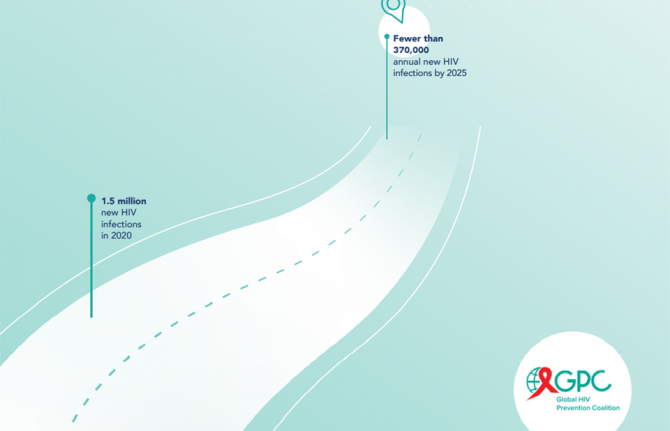

Press Release
With new infections 1 million higher than the 2020 target, UNAIDS and partners convene emergency meeting on HIV prevention
10 October 2022 10 October 2022HIV experts and implementers from around the world join UNAIDS in South Africa to set targets and put precision prevention programming into practice
JOHANNESBURG/GENEVA, 10 October 2022—New HIV infections are rising in an alarming number of countries, regions and cities around the world. There were 1.5 million new HIV infections in 2021—1 million higher than the 2020 target of 500 000. To support countries in driving down new infections UNAIDS and partners have brought together HIV prevention experts and implementers from the 28 countries with the highest rates of new infections to establish why they are failing to decline at scale, to discuss solutions and to help countries set ambitious prevention targets.
The 28 countries which account for three quarters all new HIV infections around the world are part of the Global HIV Prevention Coalition. The coalition was established in 2017 to build commitment, momentum, investment and accountability across governments, civil society, donors and the private sector to implement large-scale, high-coverage, equitable and high-quality prevention programmes.
During the three-day meeting participants will define country needs relative to implementing the 2025 Prevention Roadmap, develop critical steps required to implement the Road Map, including country-specific milestones, and identify strategic shifts required to work as a coalition and strengthen cross-country collaboration.
The meeting comes at a critical time. UNAIDS recent report In Danger showed that new HIV infections dropped by only 3.6% between 2020 and 2021, the smallest annual decline since 2016. It showed that in 2021, an adolescent girl or young woman (between 15—24 years old) became infected with HIV every two minutes and that 250 000 adolescent girls and young women were newly infected with HIV—more than 80% of whom were in sub-Saharan Africa. In this region adolescent girls and young women are three times more likely to acquire HIV than their male counterparts. Multiple vulnerabilities—including harmful social norms and practices, and social, economic and gender inequalities—are blocking progress for adolescent girls and young women.
“The urgency of making prevention work cannot be overemphasized,” said Anne Githuku-Shongwe, UNAIDS Regional Director for East and Southern Africa. “The opportunity we have now is to scale up what works while investing our attention on the stubborn social and structural barriers that keep girls and key populations vulnerable to new HIV infections.”
In 2021, UNAIDS estimated that key populations including gay men and other men who have sex with men, people who inject drugs, sex workers, transgender people, and people in prisons and other closed settings and their sexual partners accounted for 70% of new HIV infections worldwide showing that HIV prevention efforts must be concentrated among the marginalized and most vulnerable.
“Implementing this road map cannot be business as usual,” said Eamonn Murphy, UNAIDS Deputy Executive Director a.i. Programme. “We need to be honest—we need more political leadership, more investment and a greater commitment to reach key populations to drive down new HIV infections.”
When countries scale up combination HIV prevention programmes striking successes can be achieved. For example, Côte d’Ivoire’s early expansion of key population programmes and an increase in treatment coverage contributed to a 72% decline in new HIV infections between 2010–2020. In South Africa, new HIV infections decreased by 45% in that same period as the country expanded HIV treatment and voluntary medical male circumcision, while Kenya used the same approach to reduce HIV incidence by 44%.
In other regions, several countries have achieved steep reductions in new HIV infections by focusing their combination prevention programmes on the needs of key populations. In Cambodia, Thailand and Viet Nam, new HIV infections declined by more than 60% between 2010–2020. They also fell by around half in El Salvador, Republic of Moldova and Sri Lanka showing that progress is possible.
Dr Thembisile Xulu, National AIDS Commission Director for South Africa said, “This is a great opportunity for us to strategize and strengthen our relationships among countries, share experiences and rely on each other’s strengths to reduce the rate of new infections—the hard work starts now.”
Countries have committed to a new target of reducing new HIV infections to 370 000 by 2025, a target which is achievable, but only if efforts are stepped up to reach people being left behind. The HIV Prevention Roadmap has been designed to help countries reach their targets. It includes a 10-point plan and country specific milestones to get countries on track. The new HIV prevention targets include prioritized comprehensive packages of HIV prevention services and ensuring they are available and used by 95% of people at risk of HIV infection.
The meeting in South Africa was convened by the Global Prevention Coalition in collaboration with UNAIDS, UNFPA, the National AIDS Commission Forum and the Bill and Melinda Gates Foundation.
UNAIDS
The Joint United Nations Programme on HIV/AIDS (UNAIDS) leads and inspires the world to achieve its shared vision of zero new HIV infections, zero discrimination and zero AIDS-related deaths. UNAIDS unites the efforts of 11 UN organizations—UNHCR, UNICEF, WFP, UNDP, UNFPA, UNODC, UN Women, ILO, UNESCO, WHO and the World Bank—and works closely with global and national partners towards ending the AIDS epidemic by 2030 as part of the Sustainable Development Goals. Learn more at unaids.org and connect with us on Facebook, Twitter, Instagram and YouTube.
Contact
UNAIDS JohannesburgGloria Byaruhanga
tel. +258 842857702
byaruhangag@unaids.org
UNAIDS Geneva
Sophie Barton-Knott
tel. +41 79 514 6896
bartonknotts@unaids.org
UNAIDS Media
communications@unaids.org
